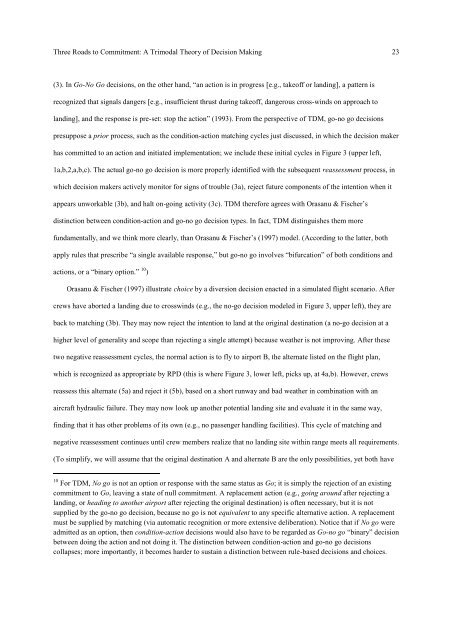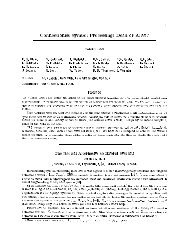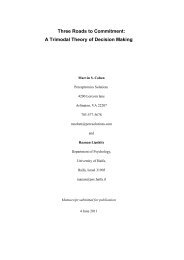Three Roads to Commitment: A Trimodal Theory of Decision Making
Three Roads to Commitment: A Trimodal Theory of Decision Making
Three Roads to Commitment: A Trimodal Theory of Decision Making
You also want an ePaper? Increase the reach of your titles
YUMPU automatically turns print PDFs into web optimized ePapers that Google loves.
<strong>Three</strong> <strong>Roads</strong> <strong>to</strong> <strong>Commitment</strong>: A <strong>Trimodal</strong> <strong>Theory</strong> <strong>of</strong> <strong>Decision</strong> <strong>Making</strong> 23<br />
(3). In Go-No Go decisions, on the other hand, “an action is in progress [e.g., take<strong>of</strong>f or landing], a pattern is<br />
recognized that signals dangers [e.g., insufficient thrust during take<strong>of</strong>f, dangerous cross-winds on approach <strong>to</strong><br />
landing], and the response is pre-set: s<strong>to</strong>p the action” (1993). From the perspective <strong>of</strong> TDM, go-no go decisions<br />
presuppose a prior process, such as the condition-action matching cycles just discussed, in which the decision maker<br />
has committed <strong>to</strong> an action and initiated implementation; we include these initial cycles in Figure 3 (upper left,<br />
1a,b,2,a,b,c). The actual go-no go decision is more properly identified with the subsequent reassessment process, in<br />
which decision makers actively moni<strong>to</strong>r for signs <strong>of</strong> trouble (3a), reject future components <strong>of</strong> the intention when it<br />
appears unworkable (3b), and halt on-going activity (3c). TDM therefore agrees with Orasanu & Fischer’s<br />
distinction between condition-action and go-no go decision types. In fact, TDM distinguishes them more<br />
fundamentally, and we think more clearly, than Orasanu & Fischer’s (1997) model. (According <strong>to</strong> the latter, both<br />
apply rules that prescribe “a single available response,” but go-no go involves “bifurcation” <strong>of</strong> both conditions and<br />
actions, or a “binary option.” 10 )<br />
Orasanu & Fischer (1997) illustrate choice by a diversion decision enacted in a simulated flight scenario. After<br />
crews have aborted a landing due <strong>to</strong> crosswinds (e.g., the no-go decision modeled in Figure 3, upper left), they are<br />
back <strong>to</strong> matching (3b). They may now reject the intention <strong>to</strong> land at the original destination (a no-go decision at a<br />
higher level <strong>of</strong> generality and scope than rejecting a single attempt) because weather is not improving. After these<br />
two negative reassessment cycles, the normal action is <strong>to</strong> fly <strong>to</strong> airport B, the alternate listed on the flight plan,<br />
which is recognized as appropriate by RPD (this is where Figure 3, lower left, picks up, at 4a,b). However, crews<br />
reassess this alternate (5a) and reject it (5b), based on a short runway and bad weather in combination with an<br />
aircraft hydraulic failure. They may now look up another potential landing site and evaluate it in the same way,<br />
finding that it has other problems <strong>of</strong> its own (e.g., no passenger handling facilities). This cycle <strong>of</strong> matching and<br />
negative reassessment continues until crew members realize that no landing site within range meets all requirements.<br />
(To simplify, we will assume that the original destination A and alternate B are the only possibilities, yet both have<br />
10 For TDM, No go is not an option or response with the same status as Go; it is simply the rejection <strong>of</strong> an existing<br />
commitment <strong>to</strong> Go, leaving a state <strong>of</strong> null commitment. A replacement action (e.g., going around after rejecting a<br />
landing, or heading <strong>to</strong> another airport after rejecting the original destination) is <strong>of</strong>ten necessary, but it is not<br />
supplied by the go-no go decision, because no go is not equivalent <strong>to</strong> any specific alternative action. A replacement<br />
must be supplied by matching (via au<strong>to</strong>matic recognition or more extensive deliberation). Notice that if No go were<br />
admitted as an option, then condition-action decisions would also have <strong>to</strong> be regarded as Go-no go “binary” decision<br />
between doing the action and not doing it. The distinction between condition-action and go-no go decisions<br />
collapses; more importantly, it becomes harder <strong>to</strong> sustain a distinction between rule-based decisions and choices.




